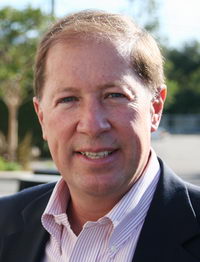Tuesday, March 16, 2010
Interview with Joe Fisher, Contour Energy

Earlier this month, Azusa-based CFX Battery, a stealthy battery technology spinout from Caltech, announced it had raised a new round of funding worth $14.2M. This week, the firm announced that it was renaming itself Contour Energy (www.contourenergy.com)--and said it was ready to talk about what its battery technology is all about. Joe Fisher, the firm's CEO, sat down with us and explained what Contour Energy is all about.
Joe, thanks for the time. What's the story behind the new name, and what can you tell us about your technology?

How did Contour Energy spin out of Caltech?
Joe Fisher: Back about three years ago, Caltech took some of the intellectual property involved with this to an event, where once a year they invite venture capital groups to come in. The different professors present to the VC community, about new things and opportunities for new businesses. As a result, in 2007, our three lead investors -- including CMEA Capital, U.S. Venture Partners, and Harris & Harris--helped form the company as a spinout from Caltech with a Series A round in June of2007. That round was worth $15.2M, but was tranched into three installments. About half of that money came in June, with the rest over the last two and a half years. Our headquarters are now in Asuza, because we weren't able to get permits in Pasadena. In Asuza, we have a 16,000 square foot facility, and we're just about to double our footprint to almost 32,000 square feet as we get our first production equipment installed.
Why is the technology you have better than what else is out there?
Joe Fisher: It's a relatively mature chemistry, but the work at Caltech involved the use of new materials--nanomaterials as well as graphites, which were not around 25-30 years ago. Under the leadership of our 3 co-founders, Dr. Grubbs, Dr. Hamwi, and Dr. Ozawa, they took a relatively mature chemistry and took it to the 21st century through materials. That's what we licensed from Caltech, and now, with our own people, we've been able to take it to the next level, not only from the technology but also the design perspective. In the battery space, there are three factors that go into things, including materials, the fundamental science, as well as the design. One of the things we've been able to do, is we've patented a cathode where we can dial in the amount of energy, or power, or any combination we need. We've targeted six end use applications, and in all of those six areas the fundamental difference is the process and the materials.
One of the usual barriers to entry in markets is cost--how does your technology compare?
Joe Fisher: Initially, it will be a bit higher due to our small volumes. But, because of our value-performance proposition we'll cost a little more than the existing chemistries out there. However, if you take into consideration run time, the broad temperature performance, and the ability to supply high rate/drain, the value proposition is very compelling.
You mention this technology, and using fluorine, has been around--why isn't anyone else using this in their battery technology?
Joe Fisher: I can't speak for other people, but what we found, is if you look at the periodic table and look at the polarity difference between lithium and fluorine, it's a natural. It gives you the best, potential, theoretical capability of any of two elements on the periodic table. Thankfully, because of Caltech and CRNS--the Center for National Research and Science, where the work was done, we have been able to take a look beyond lithium, where there are lots of players, where the chemistry was developed and led by the Japanese, and now the Koreans, and lots of startups in the U.S. We're now able to first commercialize a primary product, a lithium primary, and then rather than being a me-too in lithium ion batteries, we are going on to the next generation, where we think we have a compelling story between the materials and our fundamental technology.
When do you expect to have product into the market?
Joe Fisher: Our plan calls for first revenue in Q4 of this year, with our lithium primary. Our strategy is then to take the funds and positive cash flow, to further our research on advanced rechargables.
Finally, what's the next big target for you?
Joe Fisher: Over the next two quarter, we are doubling our production space, and getting actual production equipment installed. We've so far built out our laboratories, which are state of the art, and we have prototype equipment. But, to really commercialize this we need to have production equipment which can make thousands a day, rather than tens a day. The next two quarters will be ramping production, and qualifying the product. We've had our product sampling in several areas, and now our major customers want to see our ability to make these day-in and day-out, on a bell shaped curve.
Thanks!